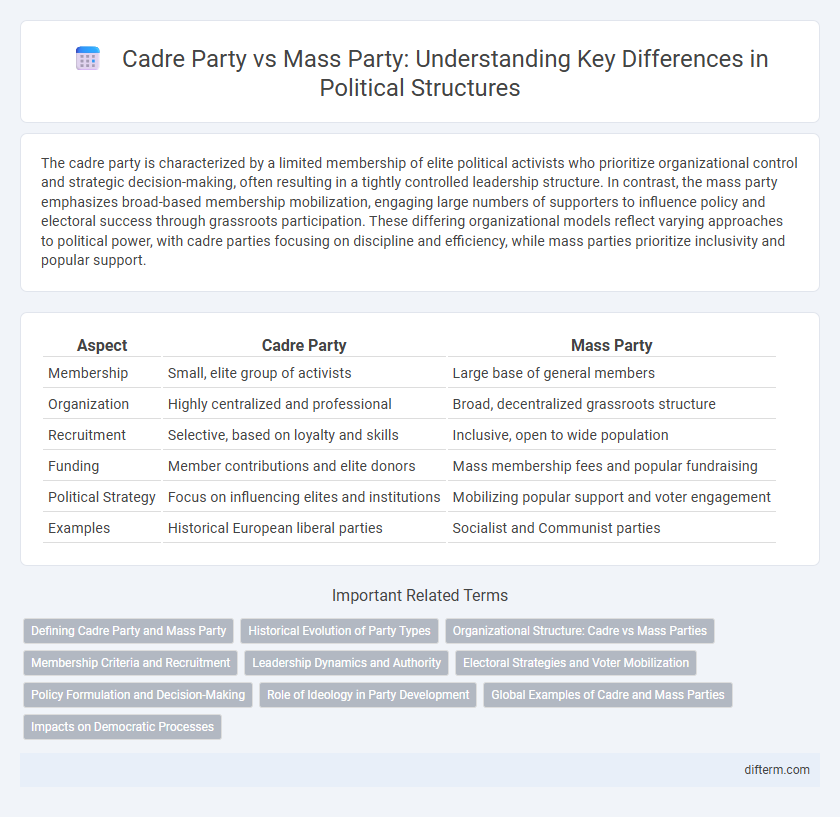The cadre party is characterized by a limited membership of elite political activists who prioritize organizational control and strategic decision-making, often resulting in a tightly controlled leadership structure. In contrast, the mass party emphasizes broad-based membership mobilization, engaging large numbers of supporters to influence policy and electoral success through grassroots participation. These differing organizational models reflect varying approaches to political power, with cadre parties focusing on discipline and efficiency, while mass parties prioritize inclusivity and popular support.
Table of Comparison
| Aspect | Cadre Party | Mass Party |
|---|---|---|
| Membership | Small, elite group of activists | Large base of general members |
| Organization | Highly centralized and professional | Broad, decentralized grassroots structure |
| Recruitment | Selective, based on loyalty and skills | Inclusive, open to wide population |
| Funding | Member contributions and elite donors | Mass membership fees and popular fundraising |
| Political Strategy | Focus on influencing elites and institutions | Mobilizing popular support and voter engagement |
| Examples | Historical European liberal parties | Socialist and Communist parties |
Defining Cadre Party and Mass Party
A cadre party is a political organization primarily composed of a small, elite group of politically experienced members who focus on specialized tasks such as strategy and leadership, often emphasizing quality over quantity. In contrast, a mass party seeks to recruit a broad base of ordinary members, encouraging widespread public participation and mobilization to build extensive support. The distinction hinges on the cadre party's reliance on a professionalized leadership class versus the mass party's effort to engage large segments of the population.
Historical Evolution of Party Types
Cadre parties emerged in the 19th century, characterized by a focus on elite organization and limited membership, primarily serving the interests of political elites and emphasizing legislative influence over mass mobilization. Mass parties developed in the late 19th and early 20th centuries, driven by industrialization and democratization, prioritizing broad-based membership, grassroots activism, and mobilizing large segments of the working class. The historical evolution from cadre to mass parties reflects the democratization process and changing social structures, highlighting a shift from elite-driven politics to organized mass participation in electoral politics.
Organizational Structure: Cadre vs Mass Parties
Cadre parties feature a small, elite leadership emphasizing centralized decision-making and limited membership focused on political expertise and influence. Mass parties rely on large, broad-based memberships with extensive grassroots organizations designed to mobilize popular support and maintain strong ties to diverse social groups. The organizational structure of cadre parties promotes efficiency and control, while mass parties prioritize inclusivity and mass participation.
Membership Criteria and Recruitment
Cadre parties typically restrict membership to elite, politically experienced individuals who demonstrate loyalty and expertise, emphasizing selective recruitment through networks and vetting processes. Mass parties adopt broad-based membership criteria, aiming to mobilize large segments of the population, often recruiting through grassroots campaigns and inclusive outreach. The distinction in membership criteria and recruitment strategies significantly shapes each party's organizational structure and political influence.
Leadership Dynamics and Authority
Cadre parties concentrate leadership authority within a small, elite group, emphasizing centralized decision-making and professional political management. Mass parties rely on widespread membership participation, distributing authority among grassroots leaders to reflect collective interests. Leadership dynamics in cadre parties prioritize expertise and control, while mass parties emphasize representativeness and mobilization.
Electoral Strategies and Voter Mobilization
Cadre parties typically rely on a narrow, highly organized group of elite members to control electoral strategies, focusing on targeted campaigning and influence within political institutions. Mass parties emphasize broad voter mobilization through extensive grassroots networks and ideological appeals to attract wide public support, often fostering party loyalty across diverse social groups. The effectiveness of each electoral strategy depends on the political context, with cadre parties excelling in elite-driven systems and mass parties thriving in democratic environments where voter turnout is crucial.
Policy Formulation and Decision-Making
Cadre parties typically rely on a small, elite group of leaders for policy formulation and decision-making, emphasizing expertise and centralized control. Mass parties engage a broad membership base in policy development, fostering grassroots participation and collective input. This distinction influences how responsive each party is to public demands and internal consensus during the political process.
Role of Ideology in Party Development
Cadre parties typically prioritize organizational efficiency and elite leadership over strict ideological commitment, focusing on pragmatic governance and networking among party members. Mass parties emphasize widespread grassroots mobilization and ideology as a core driver, fostering strong party identity and loyalty through clear, consistent ideological platforms. The role of ideology in party development is central to mass parties, shaping policy agendas and voter alignment, whereas cadre parties often adapt ideology flexibly to maintain elite consensus and administrative functionality.
Global Examples of Cadre and Mass Parties
Cadre parties, such as the British Conservative Party and the German Christian Democratic Union, are characterized by a limited, elite membership and emphasize organizational discipline and parliamentary activity. Mass parties like the Indian National Congress and the Spanish Socialist Workers' Party rely on broad popular support, extensive grassroots mobilization, and ideological commitment. Global examples highlight the cadre party's focus on political elite coordination, while mass parties prioritize mass membership and social transformation.
Impacts on Democratic Processes
Cadre parties often centralize decision-making among elite members, which can limit broad-based participation and reduce transparency in democratic processes. Mass parties engage large segments of the population, fostering political mobilization and enhancing representativeness but may risk populism or internal factionalism. The balance between these models shapes citizen engagement, accountability, and the overall quality of democracy.
Cadre party vs Mass party Infographic

 difterm.com
difterm.com